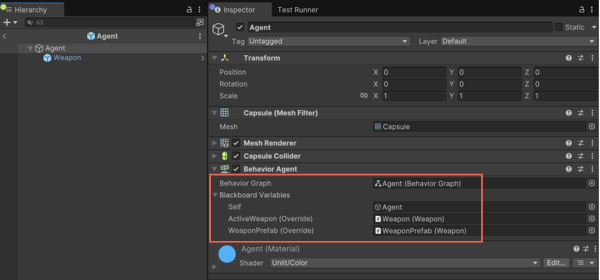How behavior graph works
The Agent.graph defines the core behavior logic for each capsule agent in the sample.
Use this section to do the following:
- Understand how the graph works
- Assign blackboard variables through the prefab
- Learn how the agents continuously choose and move to random positions
- Use the ChooseTargetPosition node adds simple randomized behavior
- Enable variable overrides and runtime serialization with prefab setup
Understand the graph
The sample behavior graph, Agent.graph, defines the logic that drives each capsule’s behavior. It uses a combination of blackboard variables and node sequences to control movement and interaction.
To open the behavior graph, double-click Agent.graph. This opens the Unity Behavior editor.
Blackboard variables
Agent.graph uses the following blackboard variables:
| Variable | Description |
|---|---|
| Self | Reference to the agent’s own GameObject (automatically assigned). |
| Target Position | A Vector3 position the agent navigates to. |
| ActiveWeapon | The currently held weapon. |
| WeaponPrefab | Reference to the weapon prefab to instantiate. |
Behavior graph flow
The flow of the graph determines how the agent behaves over time.
In Agent.graph, the logic flow is as follows:
The On Start node has Repeat set to true, so that the graph can loop continuously.
A Sequence node ensures actions run in the following order:
- ChooseTargetPosition node: selects a random location
- Navigate to Target Position: moves the agent to that location
This loop continues indefinitely and produces autonomous, randomized movement for each capsule. To learn more about the nodes, select the relevant node and view the details in the Inspector.
Prefab setup
Each capsule is an Agent prefab with a Behavior Agent component.
- The Self variable is automatically bound to the GameObject.
- The ActiveWeapon (Override) and WeaponPrefab (Override) variables are manually assigned.

The setup shows how to save and load objects that reference other objects in the scene or external prefabs.
Unity can’t serialize GameObject references directly. To work around this, the sample uses a GameObjectResolver to resolve object references during deserialization, based on saved agent identifiers. The SerializationExampleSceneController script includes a basic implementation of this resolver.
Write custom behavior with ChooseTargetPosition
The ChooseTargetPosition script is a simple example of a custom behavior node. It picks a random point within a defined range and sets this as the agent’s TargetPosition.